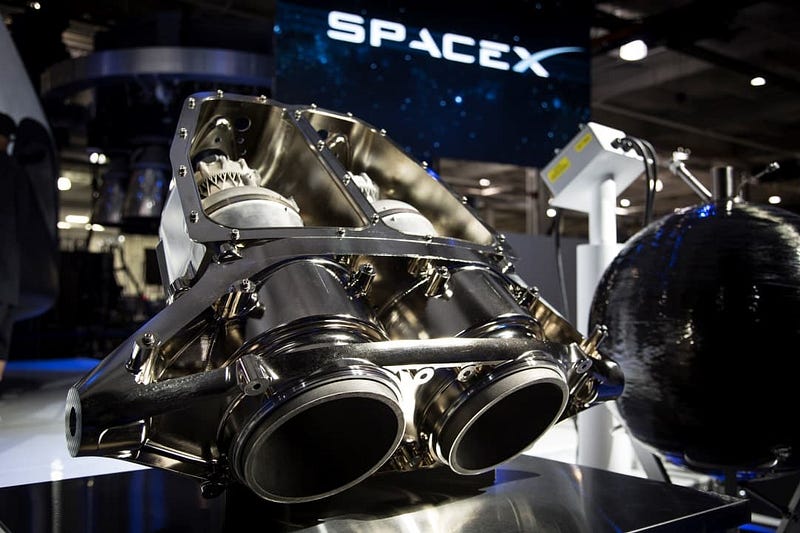Understanding the Cause Behind the SpaceX Explosion Incident
Written on
Chapter 1: Overview of the Incident
In April, a Crew Dragon engine test concluded with a dramatic explosion just moments before ignition. SpaceX has since determined the cause of this incident. The explosion occurred on April 20 during a static fire test at Cape Canaveral Air Force Station, Florida.
The mishap took place at 2:13 PM EDT, occurring just one-tenth of a second before the last thrusters were set to ignite. A nitrogen tetroxide (NTO) leak, which serves as the oxidizer for the vehicle, ignited a check valve, resulting in the explosion that destroyed the engine.

A SuperDraco rocket engine, similar to the one that exploded during the static fire test, is shown above. Image credit: SpaceX.
Prior to the explosion, a faulty component permitted NTO to seep into high-pressure helium tubes during ground operations. This NTO subsequently infiltrated a helium check valve during the rapid activation of the launch escape system, culminating in the titanium valve's structural failure. This failure triggered the ignition that caused the explosion.
The Crew Dragon spacecraft is equipped with two distinct propulsion systems: 16 Draco thrusters that operate at low pressure for maneuvering in orbit, and a high-pressure SuperDraco engine, which consists of eight Draco thrusters designed to ensure crew safety during catastrophic events.

The Demo 1 capsule is shown post-mission recovery in March. Image credit: NASA TV.
Static fire tests involve tethering engines to a platform and igniting them to assess system performance. SpaceX successfully completed a demonstration mission to the International Space Station (ISS) in March 2019. The April test aimed to identify potential flaws before an in-flight abort demonstration.
SpaceX stated, “The static fire test and anomaly provided a wealth of data. Insights gained from this and other tests in our comprehensive campaign will enhance the safety and reliability of SpaceX’s flight vehicles.”
The private aerospace company, founded by Elon Musk, had previously conducted tests with 12 Draco thrusters without incident. Following the explosion, a large reddish plume of smoke was visible at the test site. The area was evacuated, and wind conditions were closely monitored. SpaceX collaborated with the US Air Force to clear debris and collect wreckage for analysis. An investigative team was formed, including representatives from SpaceX, NASA, the Federal Aviation Administration (FAA), and the National Transportation Safety Board (NTSB).
The first video discusses the facts behind SpaceX's dramatic Starship explosions, offering insights into the causes and implications of the incident.
Chapter 2: Preventive Measures and Future Implications
Following the explosion, improvements were made to the engine systems. New measures include eliminating any potential pathways for propellant to infiltrate the gaseous pressurization system. Check valves have been replaced with burst disks, which remain sealed until pressure opens them. SpaceX officials are confident these adjustments will mitigate the risk of similar incidents in the future.
The explosion site was cleared and operational by June 25, allowing SpaceX to successfully launch their Falcon Heavy rocket on the STP-2 mission, landing two side boosters at designated landing zones.
The second video from BBC News explores the reasons behind Elon Musk's Starship rocket explosion, providing further context on the incident.
The Crew Dragon spacecraft is engineered to transport astronauts to and from the International Space Station. Since the cessation of the Space Shuttle program in 2011, NASA has paid $80 million per astronaut for flights to the ISS, relying on Russian spacecraft. The Crew Dragon is being developed under NASA’s Commercial Crew Program.
Although SpaceX aimed to launch human missions by the end of 2019, this explosion is expected to delay those plans until at least 2020, potentially affecting the organization's ambitions for crewed missions to the Moon and Mars.
Did you enjoy this article? Subscribe to The Cosmic Companion Newsletter!